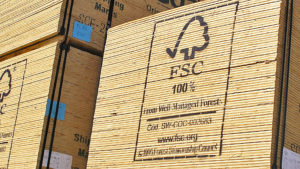Leaders trying desperately to restore healthy forests and rebuild the forestry economy, from California to Australia, need all the help they can get. The not-so-new idea of forest certification could still be a powerful ally.
For years, forest restoration has meant developing new products and new markets for the millions of tons of material that must be removed from overgrown forests, but any cutting of any tree of any kind in any place still faces stiff opposition. In the U.S., this seemingly-permanent impasse has cost tens of thousands of jobs, millions of dollars in litigation, and several thousand homes lost to catastrophic wildfires that have destroyed over 100 million acres of forests in the last 20 years. It is getting worse each year.
 A decade ago there was much fanfare about reducing the political difficulty of forest management by using the term “certified.” It gives consumers a way to know that forest products they use are produced in a sustainable way, using standards designed to restore forests, not destroy them. There are “certified” building materials available in many markets, and furniture produced with “certified” lumber is increasingly popular. There are a growing number of “certified forests” from which such products are taken, about half of them in the U.S. It is a very appealing strategy, and could be used much more extensively, as a way to re-assure the public of a pro-active agenda based on healthy forests.
A decade ago there was much fanfare about reducing the political difficulty of forest management by using the term “certified.” It gives consumers a way to know that forest products they use are produced in a sustainable way, using standards designed to restore forests, not destroy them. There are “certified” building materials available in many markets, and furniture produced with “certified” lumber is increasingly popular. There are a growing number of “certified forests” from which such products are taken, about half of them in the U.S. It is a very appealing strategy, and could be used much more extensively, as a way to re-assure the public of a pro-active agenda based on healthy forests.
Unfortunately, the tool became so popular that a raging controversy developed over who gets to decide what forests, companies, and products can be certified. Dozens of certification groups evolved around the world, from the American Tree Farm System to Rainforest Alliance, which combined conservationists, industry representatives, and governments to create consensus standards, and certify forests and practices as sustainable. Participation was always voluntary, but the market for certified products brought higher prices. However, the certification process is also something of a power play, especially from a heavy-handed organization called the Forest Stewardship Council (FSC, based in Germany) which has always wanted to become the only recognized standard – even pushing for regulatory mandates to ensure that it gets all the money and power associated with being the keeper of the worldwide standard.
That attempt was stymied by an American Consumer Institute study on the “Monopolization of Forest Certification,” with powerful facts illustrating how such a monopoly would not only increase consumer costs, but actually undermine sustainability. That’s because when such certification programs become monopolies, they become driven by money, which leads to corruption. Sometimes certification has even been used as a cover for trafficking illegal lumber.
Put simply, there is no common standard for determining what is sustainable and healthy in different climates with different forest types. Attempts to establish a monopoly on certification, and to substitute mandates for voluntary compliance and consumer choice, showed how thoroughly the environmental movement had lost its way to the point of hurting the environment, by discouraging certification. Certification requires payment of fees, and monopoly always leads to higher fees. Such money and power is a boon to groups like the FSC, but has become a significant disincentive to forestry companies already teetering on the edge of economic viability. Thousands of companies do not belong to any of these groups.
The variety of certifications also served to confuse the marketplace, and weaken the brand, so that lumber consumers still don’t really have that choice. Most lumber is now sold in the big box stores, and buyers cannot tell whether it is certified or not. There is still hope, though. An umbrella organization finally emerged, based in Geneva (naturally) called PEFC, the “Programme for the Endorsement of Forest Certification.” Now, certification organizations in 53 countries belong to PEFC and implement standards democratically agreed upon by the members. That ensures best practices are implemented by all – except the thousands of forest companies unwilling to pay fees to such groups. Thus, after years of promising discussion, certification has still not stopped deforestation in the Amazon, or helped restore dead forests in the U.S.
Restoring forests requires changing the politics of logging. Reassuring consumers that forest practices are responsible and sustainable is essential. Certification could still be an extremely effective way to do that, if consumers had any idea what it means, and where to get such products. That would strengthen the market incentives for maintaining healthy forests. That’s why forest “sustainability” standards must be set by communities of diverse experts working together to improve forests, not organizations seeking money and power.
This column originally appeared in the Grand Junction Daily Sentinel January 24, 2020.




Comments on this entry are closed.
{ 1 trackback }